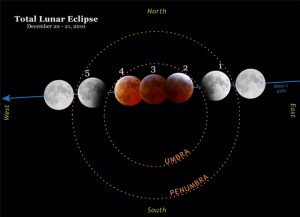Much has been said about the upcoming eclipse. This is the first time in almost four hundred years that an eclipse has coincided with the solstice. People deem this to be particularly significant.
In Vedic astrology and astronomy, each eclipse is given attention. Eclipses occur when either or both the nodes, Rahu (the North node) or Ketu (the South node) fall within a certain astronomical degree of the Sun and / or Moon, depending on the type of eclipse.
The nodes are always directly opposite each other. When it’s a full Moon, the Sun and Moon are opposite each other. When both the Sun and Moon fall on either side of the Rahu/ Ketu axis, it’s a lunar eclipse, such as tonight. When there is a new Moon, where the Sun and Moon are at the same degree in the same sign, and they are within a certain zone of the nodes, there is a solar eclipse, as is happening on January 4.
The eclipse begins on tonight Monday, Dec. 20th, at 10:33 pm PST (according to NASA). The peak point is at 11:41 pm PST and lasts for 72 minutes afterwards.
While many people are intent on watching the eclipse, this is never recommended in the Vedic tradition. The mythology related to the nodes, Rahu & Ketu can help explain why.
What follows is a very simplified version of the tale.  The nodes were initially embodied in demonic form and they were very desirous of immortality. They heard of a private party where the Gods were celebrating and imbibing amrita, the nectar of immortality. A particular demon specially desired to join the party, donned a disguise, and gained admittance. The amrita was passed around the table and the demon tasted it and was then discovered. One of the Gods threw a discus and chopped the demon into two halves: the head (Rahu) and the tail (Ketu). The head, Rahu, that has now tasted the nectar of immortality is forever questing for that elixir and is never satiated.
The nodes were initially embodied in demonic form and they were very desirous of immortality. They heard of a private party where the Gods were celebrating and imbibing amrita, the nectar of immortality. A particular demon specially desired to join the party, donned a disguise, and gained admittance. The amrita was passed around the table and the demon tasted it and was then discovered. One of the Gods threw a discus and chopped the demon into two halves: the head (Rahu) and the tail (Ketu). The head, Rahu, that has now tasted the nectar of immortality is forever questing for that elixir and is never satiated.
Thus the nodes are correlated with illusion and disguise. Since they are “nodes” and not real planets, they are invisible as we are always approximating their position in the sky. Rahu itself has to do with unending questing, desire, ambition, and a hunger for whatever it feels it still needs to attain. There is the connotation of desiring to partake in a situation and with a group where it does not belong. Ketu is usually more often associated with spiritual pursuits, though the theme of questing is still active.
The nodes have the capacity to grab a hold of our mind and make it engage in relentless pursuits, to make the mind feel that it has so much more to achieve, to seek another source of stimulation, to unearth a greater challenge. The mind can become unfocused due to the grasping nature of the nodes.
When a person is undergoing a cycle of the nodes, this becomes more pronounced, and will unfold in the forms indicated by the nodes’ natal placement and its current placement by transit. Currently, Rahu is in Sagittarius and Ketu is in Gemini.
Today, the Moon is in Gemini and the Sun is in Sagittarius. The Moon stays in a constellation (i.e. Gemini) for about 2.5 days and the Sun remains in a constellation for 30 days. This tendency of questing also breaks out during an eclipse. Since this eclipse is visible in North America, it is more significant than one that is not visible on this continent. Just think how many people are figuring out when / how / where to best view the eclipse.
Rather than gazing at the Moon, it’s recommended that a person spend the time during an eclipse indoors, engaged in meditation or other spiritual practices and keep an inward focus. It’s a time to eat lightly and eat pure foods. Shades should be drawn and food should not be kept out and exposed to the moonlit rays.
In astrology, we speak of the dance between free will and fate. This is a time where we can choose how to spend our evening or night. Whatever we do, we can maintain awareness of the state of our mind.